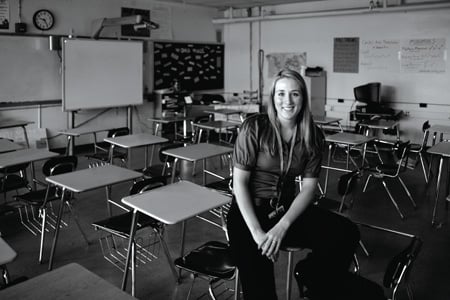Great Expectations
In the country’s lowest performing schools one national education reform group is trying to use its young, energetic teachers to make a difference and to close the ever-daunting achievement gap. In Charlotte, one of those teachers is defying the odds—school violence, low funding, poor infrastructure—to do just that.

It’s late April. In less than a month Stephanie Pickering’s students at Garinger High School in east Charlotte have to take their End of Course tests. Pickering, twenty-three and in her second year at Garinger, has been teaching her students algebra since August. She has often arrived at school before it was light outside and left after dark. She has taught and retaught and encouraged and reminded and tutored and retaught again. She has called parents and demanded her students’ attention. Her students will tell you that she’s their most energetic teacher.
But it’s caught up with her. With one month of cramming for the EOCs ahead, Pickering gets mononucleosis. It’s such a bad case that it spreads to her liver, causing her to develop hepatitis. And suddenly, the lively teacher is spending her days in bed while a substitute tries to keep order in her classroom.
When she returns with only two weeks until testing begins, Pickering is still exhausted, but she doesn’t have the luxury of more time off. Garinger is one of the lowest-performing high schools in the city and Pickering has been sent there to make things better—which, in this case, means having students who pass the EOCs. Her year of work will be boiled down to a few hours of testing. In those few hours she has to prove that a good teacher can triumph over problems like the violence that has plagued Garinger this year or the fact that the school’s heat often doesn’t work on cold days. She has to prove that the organization she works for—the organization that got her this job as a college graduate with no teaching experience—is effective.
The illness has made her so tired that on her first day back she has to sit down to rest occasionally as she teaches, something she’s never done. But Pickering keeps pushing. She and her class have to work even harder than usual now in the hopes that this year of long hours and hard work will pay off.
They have ten days.
Pickering is in a national teaching organization called Teach for America, a Peace Corps–like program that enlists promising graduates from the country’s top universities to teach for two or more years in low-income communities and under-resourced schools just like Garinger. The hope behind the organization is that those who spend two years in the country’s worst schools will develop a lifelong interest and investment in closing the achievement gap. And in Pickering, they’ve found the ideal corps member.
Pickering attended a public school in suburban Boston before going to Haverford College outside Philadelphia. She was on a premed track, but the summer before her senior year she took an internship in a school in South Los Angeles. She saw the problems facing students in public schools. “I decided that instead of just talking about what an injustice it was, I wanted to do something about it,” says Pickering.
She applied for Teach for America in 2008 and, after a competitive admissions process and grueling summer training, began the program in 2009. TFA teachers can be sent to any of the program’s forty-three regions throughout the country, but they are offered the chance to give their preferences. Pickering chose Charlotte with one of her reasons being that it seemed less likely to be a dangerous school district to work in compared to places like New York or Los Angeles.
Now in her second year, she has become one of the program’s local stars. She plans to continue teaching at Garinger during the 2011-2012 school year, even though her time as a corps member ended in June. Although some TFA alumni take this path, it isn’t typical—only 56 percent of Charlotte’s 2009 class will teach for a third year. One of its biggest criticisms is that Teach for America only exacerbates the problem of teachers coming in and then quickly moving out of low-performing schools. Garinger, in particular, has faced this problem, even to the extent that in the past there were not enough teachers to fully staff the school.
In recent years though there have been more teachers than the school system can afford to pay, which brings up a new set of concerns regarding TFA teachers, who are paid regular salaries by their school districts. Critics complain that TFA teachers, who are likely—and even expected—to leave after two years, get jobs that could have been given to teachers who would stay longer with more subsequent training and experience. These problems create even more pressure for TFA teachers to ensure their classrooms perform well in tests.
During Pickering’s first year at Garinger, the 2009-2010 school year, there were 233 corps members teaching an estimated 14,000 Charlotte students, 74 percent of whom qualified for free or reduced-price lunch. In the 2010-2011 school year, there were 230 members.
Having a successful program in Charlotte is especially important for the national organization because Teach for America, which is a nonprofit, has received some of its largest annual donations from the local Wells Fargo Championship.
“The business community here really does care about education,” says Tim Hurley, TFA’s executive director in the Charlotte region. “I have the benefit of seeing what that looks like in other cities and while here we just kind of accept it that people want to help public schools, in other cities they’ve given up on public schools. Charlotte is different.”
But that doesn’t mean that Charlotte faces fewer problems within its schools than other districts. Here, the achievement gap continues to be a problem. According to Hurley, on average when TFA students enter fourth grade, they’re already three grade levels behind their peers in higher-income schools. “When our teachers are coming in, they know a lot of their kids will be really far behind and they’re looking to see what they need to do to catch them up over the course of time they’re in their class,” he says. “And that’s hard. There’s no easy way to do that.”
It’s a cold and cloudy late October day, seven months before Pickering will become sick. Parked in front of Garinger are eight shiny white police cars. They’re bright against the school’s dark brick-and-concrete exterior. A male student wearing handcuffs, his dark jeans sinking down without his hands to hold them, is led out one of the school’s glass doors by an officer. The other police officers mill around inside the school’s large atrium entrance, moving between the administrative offices, speaking loudly to students and then quietly to each other.
There’s been another fight.
It won’t be the first time during the 2010-2011 school year that the school will make the news for its problem with school violence. The week before, the school’s homecoming football game came to an abrupt end when fights broke out inside the stadium and shots were fired.
It’s cold inside the atrium, which is two stories high with floor-to-ceiling windows on both sides. One side faces the school’s circular entrance and another a courtyard where typically students linger between classes, chatting as they lean on railings or sit against walls. Today though it’s empty. The school is on lockdown. Students are not allowed to walk around freely and classroom doors and outside doors are all locked shut. There are rumors of a weapon on campus and the police are searching the school.
In a large classroom on the southern part of campus, Pickering is teaching Algebra One to a full class behind her locked door. She’s enthusiastic, smiling at the class as she asks them to work out the problems she’s put on her overhead projector. She walks quickly among the students, looking at papers, encouraging some, and keeping their focus on her and their work. They’re involved, throwing their hands into the air to ask questions and give answers.
Suddenly, outside in the hall, someone hits the back classroom wall. The students jerk around in their seats, their eyes wide as they look toward the wall and its door, but when nothing happens, they slowly turn back as Pickering tries to engage them again. But it’s clear that the morning’s events have rattled them. Some go back to working out math problems, but others are still looking over their shoulders toward the door.
Being a TFA teacher is an undeniably difficult job, but the organization recruits its corps members from the top of their classes from competitive schools like Davidson, Wake Forest, and UNC-Chapel Hill. It’s the top employer of graduates at many high-ranking colleges including Dartmouth, Duke, and Georgetown. All of Charlotte’s corps members in 2011 held leadership positions in college. These are graduates who know how to work hard, typically succeed, and are likely to be much too competitive to quit when things are difficult.
Pickering, like most TFA teachers, is awake by just after 5 a.m. She makes the drive through some of the city’s toughest neighborhoods and arrives at Garinger just after 6 a.m. At night she tries to leave by 5:30 p.m., but she’s on call until 10 p.m. The students have her cellphone number and they’ve been instructed to call her if they have questions about homework in the evenings. “I get a couple of calls a night for help,” she says.
When she’s not working with her students, Pickering, like many TFA teachers, is taking courses at UNC-Charlotte to earn her certificate in secondary math education. This is another benefit of TFA; it offers annual education funding. Pickering also has frequent meetings with other corps members and her program director, which are designed to give the teachers an opportunity to learn how to improve their classroom techniques and share ideas and problems from their own classrooms. It’s a demanding schedule—especially considering that possibly the most important part of Pickering’s job is ensuring that she’s energetic with her students and excited about the material. While Teach for America has earned praise for its results, this kind of intense schedule is often criticized. Teachers who work in low-performing schools are already at risk for burning out early in their careers, but TFA teachers have especially demanding schedules, which make this seem even more likely. Pickering is looking forward to next year, when her focus will be entirely on teaching.
“I want to see what it’s like to just be a teacher,” she says. “Not to have grad school and not to have Teach for America.”
It’s early December and Charlotte is unseasonably cold. There are icy puddles in Garinger’s courtyards and the morning low was 15 degrees. Inside the building it’s freezing.
“Sorry the heat isn’t working,” Pickering says to her class, as she smiles and writes algebraic formulas across her white board. She walks to the back of her classroom, attempting once more to coax the heater to life. “You guys let me know if that’s blowing hot or cold air,
all right?”
Garinger was built in 1959 and is one of the city’s oldest public school buildings still in use. This means that despite some renovations, there are problems with its infrastructure.
The day before there was another violent disruption at the school. Two students got into a fight after school and shots were fired. No one was injured, but police recovered a gun on campus and arrested the students, and for half an hour the campus was on lockdown. Pickering was tutoring students in her classroom when the announcement was made. She followed procedure and checked the hall to see if any students needed to be brought into her room, then she turned off the lights in her classroom and moved the students into a corner where they couldn’t be seen from outside. The students—and Pickering—weren’t as bothered by the incident as they are by the negative press their school has attracted in recent months.
“I understand that it’s newsworthy,” says Pickering. “I just wish that the awesome things were equally reported. Like that last year we had an 86 percent EOC pass rate. Instead it’s police helicopters and shootings.”
Many students are absent today because their parents are nervous about sending them to school after yesterday’s incident. The students who are there are too focused on staying warm to be bothered with the previous day’s problems. All wear thick coats and most have their hoods pulled over their heads. Many have wrapped scarves around their hands and some have draped additional pieces of clothing over their laps.
It might seem impossible to distract them from their discomfort, especially with something like algebra, but Pickering manages. She plays music over the projector’s speakers as they work. As Nelly croons “Just a Dream,” she moves around the classroom, answering questions. “What’s up kiddo?” she asks as she sits down next to one student with his hand raised and then works through the problem with him. Kanye West’s “Heartless” plays and she walks over to another group of students, checking to make sure they’re doing their work correctly.
“She won’t let you sleep in class,” says Breniz Ventura, an eleventh-grader. “Some other teachers aren’t on you like Ms. Pickering. She makes math fun—and I do not like math.”
Pickering continues to move quickly through the room, bending over desks and working through their problems with them. She calls them “my dears” and repeatedly encourages them with “awesome,” “love it,” and “you guys are doing so good,” as she checks their work over their shoulders.
“You shouldn’t have doubted us, Ms. Pickering,” says Ronnie Rivera, a junior wearing a black, hooded sweatshirt and grinning as he chews hard on his gum.
“I didn’t doubt you, Ronnie,” says Pickering. “I never doubt you guys—I just sometimes doubt my ability to teach it.”
Before they’re ever placed in a Charlotte classroom TFA teachers go through a five-week intensive training course called Institute. In their classrooms, they’re required to use data and tracking to determine how each student is performing. And they’re required to attend meetings where they’re given even more instruction about how to teach.
When the Teach for America corps members meet at James Martin Middle School on a warm spring evening for one of their bisemester workshops, they could easily be mistaken for students themselves. After all, many of them were in college only a year before. Most of them haven’t had time for dinner before hurrying to the workshop, so there are snacks. Many of the teachers slouch in their child-size desk chairs, sunglasses on their heads, chewing on granola bars and looking out the window.
“Can we have class outside?” a corps member jokes. “My kids always ask me that.”
When Kelly Pomis, Pickering’s program director and the instructor for the evening’s workshop, begins to talk, she speaks in the authoritative tones of a teacher talking to students. In a yellow shirt and gray slacks with her hair pulled into a tight bun, she looks the part. Pickering is without a doubt head of the class. Image is important for TFA. All media requests go through the national office. It’s no coincidence that TFA has become a media star when it comes to education reform. My being placed with Pickering for reporting on TFA was carefully coordinated and arranged by a media-savvy organization intent on presenting a positive public image. No place is this more evident than when Pickering is in the classroom with her corp member peers. Her answers are praised, and each time she raises her hand she’s immediately called on.
Tonight many of the teachers look tired. Some have learned that the schools where they work will be closing next year, while others are simply frustrated by ongoing problems in their classrooms. All have been working long hours for months.
As the teachers share their problems it is clear there are more issues with the schools than with the students. They don’t have paper to print out enough quizzes or color printers to make tests more stimulating for students. “I’ll take care of it,” Pomis says repeatedly. TFA, which raised $189 million nationally in 2010, can supply things the schools cannot.
By late March Pickering says her students are tired of looking at her and she admits she’s getting a little tired of looking at them. They’ve been working for months together, trying to ensure they’re prepared for June’s End of Course testing. During today’s class Pickering is being observed by Pomis as well as Pomis’s manager, Michele Gasiewski. The two stand at the back of the class, where they seem to be watching the students as much as they watch Pickering.
After class Pickering explains that this class has students who, despite having taken algebra twice already, are still trying to pass their EOC. Several of the students need this credit to graduate this spring. Pomis and Gasiewski ask about specific students. They’ve noticed the ones who seem to be having problems and are interested in how Pickering is handling it.
Her responses reveal a teacher who knows much more than her student’s test scores.
“He got the lowest score possible to pass eighth grade. He’s had behavioral issues and often misses school. If he were here every day, he’d be through the roof. He’s brilliant.”
“He didn’t pass the EOC last year and he hasn’t been coming to school as much lately. He keeps telling be he’s going back to his country. His brother is in jail and I’ve never been able to get in touch with his parents.”
“He’s overconfident. And he’s always absent when I’m here after school. He’s a second-year freshman.”
The directors give feedback and suggestions, but it’s clear that Pickering has a good grasp on the situation in her class. They repeatedly tell her that her class is special. They also tell her that she should become a TFA program director. But Pickering loves teaching and insists staying at least one more year. “I don’t want to leave my babies yet,” she says.
Pickering’s students’ EOC scores come in late in the afternoon on an early June day after the students have gone home. But Pickering has promised to text them their results. And the results are good. Actually, they’re better than good. They’re the best in the school. All three of Pickering’s classes had a 100 percent pass rate. No other class in the school has a 100 percent pass rate.
She did exactly what Teach for America wants its teachers to do. She rose above the school’s problems and persisted in being a strong teacher—and got great results. The problem is, she’s only one teacher and four weeks earlier she was almost hospitalized. Not all of her students passed their EOC tests in other courses. Not all of her students will graduate. Pickering’s exhausting work paid off in her classroom, but there’s only one Pickering.
This afternoon, though, both Pickering and her students are celebrating. She texts each student to tell them they’ve passed. When she texts one student, Mohamed Hamed, he texts back asking if she can call his mom to tell her the good news. “My mom was really excited,” he says later, grinning.
Hamed attributes his success on the EOCs to Pickering’s teaching. “I don’t think I would have done as well if she hadn’t been my teacher,” he says. “She’s got so much energy. She makes you wake up and be focused.”
Breniz Ventura agrees. “She’s been a great teacher and she kept us interested,” she says. And then Ventura says exactly what TFA would hope one of its corps member’s students would say: “She told us that she was a Teach for America teacher, but it doesn’t change the way I look at her. She’s just like any other really good teacher.”







